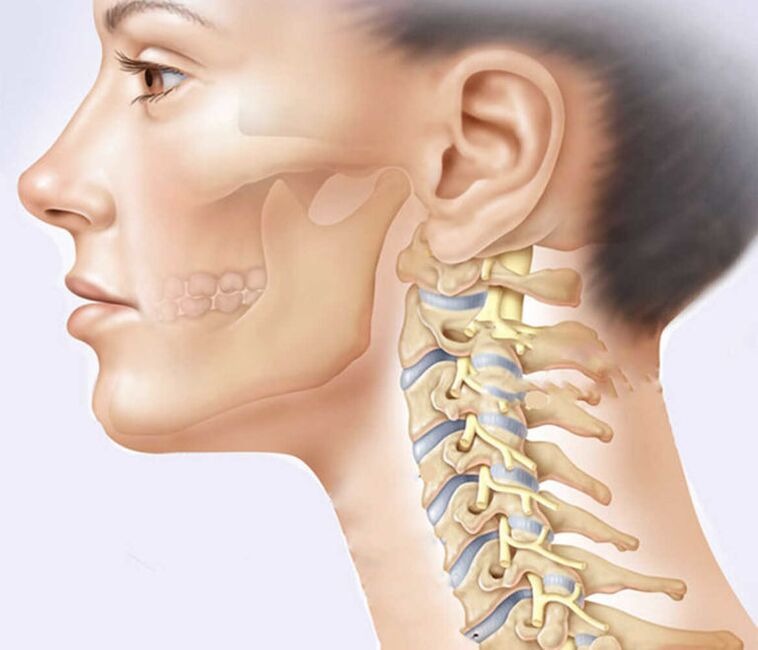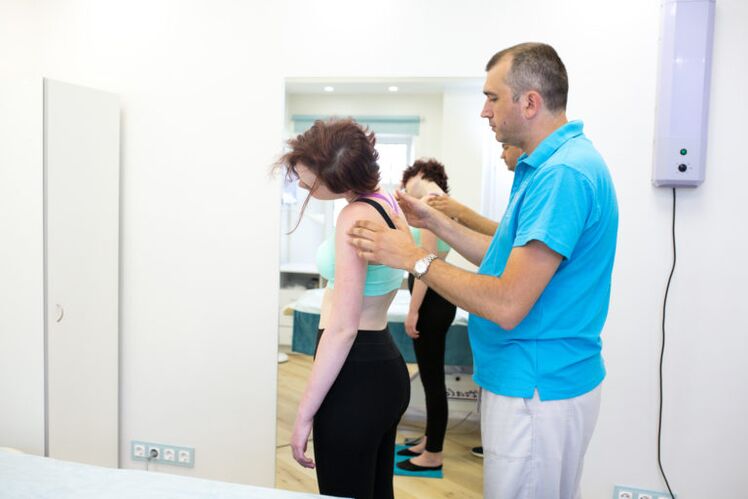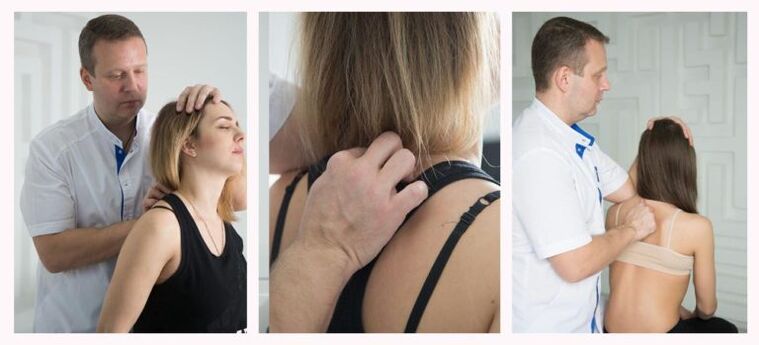Everyone experiences severe pain in the neck. There is no need for this to have an accident or an anomaly in the vertebral structure. Improper workplace arrangements, an inactive lifestyle, intense physical activity - all of these can cause severe pain. With increasing age, the manifestations of osteochondrosis can become complicated, and diseases of internal organs only add to the problem.
Acute neck pain can occur suddenly, for example, with a sharp rotation or tilt of the head. It can radiate to the head (especially to the back of the head), chest or even shoulders. Such phenomena often occur as a result of cervical lumbago (cervicago) or acute muscle spasm. We stood in the plan, lifting weights - severe neck pain could last 5-10 days, but then they disappeared. If the duration of pain is more than 10 days, they have a sharp, painful or interesting character, significantly reducing the quality of life - you should seek treatment.

Since many lymphatic ducts, large veins and arteries pass through the cervical area, any problems in them must be carefully addressed. The musculoskeletal cavity of the neck contains the thyroid gland, pharynx, the beginning of the esophagus, the larynx, and the upper part of the trachea. The neck muscles take part in the movement of the head, shoulders and even the jaw. Therefore, if you experience neck pain, you should see a doctor immediately to find out the causes and prevent some serious problems.
The doctor will check the condition of your spine and brain, take an X-ray, CT or MRI, check the level of tension in the muscles of the neck, shoulders, and upper back. Determining the cause of pain can result in the need for treatment not at all in the cervical spine. You should also be prepared to exercise to be a part of your daily life.
Severe pain in the cervical spine is a very important and practical neurological problem. Its importance is determined by the following factors:
- pain in the neck with osteochondrosis is the most common pathology caused by non -infection.
- painful sensation in the neck prone to chronic disease with exacerbation. Frequent pain can result in temporary or permanent disability.
These factors determine the importance of getting timely medical treatment. If you experience discomfort or pain, you must immediately see a specialist. Self -treatment in such cases is unacceptable, as it can lead to serious complications.
In addition, self -treatment often leads to the need for surgery and causes disability in adults.
Only a doctor can create a therapeutic regimen, including pain relief.
Kind of neck pain
Distinguish between cervical pain (cervicalgia) and cervical lumbago (cervicago). Cervicalgias are:
- superficial somatic - associated with skin damage;
- somatic in - due to damage to the cervical muscles and vertebrae;
- visceral - disseminated, arising from infection or disease of internal organs.
Cervices that affect neighboring areas are divided into two types:
- cervicobrachialgia - cervicobrachial syndrome with pain radiating from the neck to the shoulders;
- cervicocranialgia - the sensation of pain begins directly in the cervical or occipital region, and spreads to the head.
Cervices of all types can be acute or chronic. The acute phase lasts about 10 days, but without proper treatment can become chronic. Chronic pain is considered to last more than three months.
Cervicago is always an acute pain sensation that is localized in the cervical spine and does not allow you to turn the body.
If the discomfort is due to neuropathic causes, they can be central (with damage to the spinal space) or peripheral (damage to peripheral nerves).
Causes of neck pain
Conventionally, the causes of neck pain can be divided into two groups - caused by spinal diseases or caused by other factors. The first is formed against the background of intervertebral hernia, arthrosis, joint dysfunction, as well as vertebral subluxation (whiplash). The consequences of these injuries can be felt for a lifetime. The second group includes neck pain caused by infectious and endocrine disorders, tumor processes, rheumatism.
Some of the most common causes of neck pain include:
- Myofascial syndrome.It occurs against the background of neck muscle tension, sprains, excessive hypothermia. They usually cause short -term painful sensations of moderate intensity, in which head movement is often limited and muscle spasms. When pressed, pain and indentation are felt. Often, the pain caused by myofascial syndrome disappears on its own within 4-5 days.
- Osteochondrosis of the cervical spine.The disease is a degenerative-dystrophic spinal lesion, which occurs as a result of deformation and destruction of the intervertebral disc. As a result of loss of elasticity, compression and destruction of the disc, excessive facet joints, arthrosis occur, and nerve roots are pinched. This leads to the fact that the neck as a whole hurts. With increasing age, decreased hydrophilicity of cartilage causes a decrease in the distance between the vertebrae and damage to the intervertebral joints.
- Facet joint dysfunction.Damage to the structure of the intervertebral joints is one of the most common causes of whole neck pain. Cartilage becomes thinner on the articular surface. This leads to the appearance of bone growth - osteophytes. They narrow the lumen of the hole between the vertebrae, causing the nerve endings to be compressed. As a rule, this is accompanied by a dull pain (gradually increasing, with low intensity) in the neck area, which increases in the morning after sleeping in an uncomfortable state - on a high pillow, lying on your stomach. During movement, the pain may increase, but at rest, it weakens. In this case, the pain can radiate to the back of the head, ears, temples, shoulders.
- The disc is spinal and protruding.As a result of compression of the intervertebral disc, which loses its elasticity, protrusion occurs - protrusion into the spinal canal with the subsequent formation of a hernia. This leads to compression of the spinal cord, which interferes with the sensitivity of the hands - numbness, burning sensation, weakness, accompanied by pain. Shooting (one irregular side) intensifies when bending, turning the head or throwing backwards. Therefore, one should indirectly tilt his head forward and to the side opposite to the localization of pain.
- Cervical myelopathy. . . Prolonged hernia compression interferes with blood circulation in the spinal cord. Therefore, it is not just the neck that hurts. But the violation is accompanied by pain that radiates to the area between the shoulder blades and to the shoulder. They get worse while moving and do not go away even taking painkillers. The hallmarks of neck pain with cervical myelopathy are chills, numbness in the arms and legs, and fine motor disorders. Sometimes dizziness is possible, memory deteriorates, gait changes.
- Whiplash injuries.They arise as a result of a sharp bending of the neck backwards or forwards, followed by retreating in the opposite direction. Such injuries often occur during accidents, but even a fall on the back can cause it. Trauma occurs as a result of stretching and damage to muscles, intervertebral disc ligaments and cervical vertebrae. The most severe cases are accompanied by dislocations and fractures. The result of such injuries is that the whole neck and shoulders are very sore, migraines occur, muscle cramps. Concomitant symptoms include blurred vision, increased fatigue, and frequent headache attacks.
In addition, neck pain can be caused by muscle tonic syndrome. This is a condition that causes prolonged spasms of several muscle groups in the head, chest, and neck. Compression of neuromuscular triggers leads to traction, sometimes very strong pain. In particular, scalene muscle syndrome is a complex of symptoms, accompanied by violations of the nerves and blood circulation of the scalene muscles of the neck, which go from the cervical vertebrae to the ribs 1 and 2. The syndrome is characterized by pain and spasm of the cervix, which most often appear atmorning. The head in such cases is usually tilted forward and slightly towards the tense muscles. The painful sensation can be felt mild, aching, but sometimes sharp, getting stronger at night, with a deep breath, while tilting the head to the healthy side. Occasionally there is a possibility of radiating pain in the shoulder, in the axillary and interscapular areas, as well as in the anterior chest.

However, the cause of pain is not just a disease of the spine. First of all, it is necessary to exclude infectious pathologies, in particular nonspecific spondylitis or tuberculosis, epidural abscesses. Metastatic vertebral lesions can also be accompanied by persistent pain, which does not subside, but becomes worse at rest. They are characterized by an increase in body temperature, general weakness and sweating. Even a little pressure on the rotational process causes local pain attacks.
Risk factors that cause pain include flat feet, postural curvature, and strenuous exercise. Cervicalgia can occur against the background of excessive use, vibration, prolonged immobile body position (for example, with fractures).
In addition, pain can occur as a result of wearing tight and uncomfortable clothing, malnutrition and diseases of internal organs. Taking these factors into account, we obtained a wide range of clinical cases in which cervicalgia formed.
Sore neck: who to contact and what to do
If the neck is sore, traditional medicine offers drug treatment with drugs with a wide spectrum of action. They are designed to combat pain, relieve infectious or inflammatory processes, and eliminate unpleasant symptoms. Surgery is performed only in very severe cases.
Drug treatment is based on the administration of local anesthetics, analgesics (NSAIDs), hormone medications (glucocorticoids), muscle relaxants (drugs to relieve muscle tension), antioxidants, and, if necessary, antidepressants and anticonvulsants. Treatment is based on painkillers - drugs from other groups are prescribed as equivalent drugs that enhance the effect of painkillers, relieve inflammation and swelling.

The disadvantages of drug treatment are the large number of side effects and temporary pain relief. In addition, such treatment is only intended to relieve the symptoms, but is in no way aimed at the cause of the pain.
Who should be trusted to manage that important body - the neck? If the pain is severe, no specialist is needed, but the whole team carefully examines, makes an accurate diagnosis and prescribes therapy.
An integrated approach is applied, based on a combination of the following non -drug methods:
- Physiotherapy.The neck muscles are very difficult to train, therefore, when choosing an exercise, experts focus on the movement of the thoracic area, the shoulder girdle, as well as the flat load distribution on the spine. Exercise therapists select an optimal set of exercises aimed at shaping posture and relieving neck pain.
- Kinesiotherapy.The clinic uses a kinesiotherapy system. Its installation allows you to work the muscles of the cervical spine in depth. With the help of closed chain training, neuromuscular skeletal problems can be effectively managed and departmental functions can be improved.
- Osteopathy.Osteopathic neck correction is safe and painless, it is suitable for adults and children, pregnant women and professional athletes. Unlike other methods of therapy, osteopathic medicine not only eliminates the pain syndrome, but frees the patient from the source of the pain, treating the underlying disease. For this, palpation and manual manipulation techniques are used on the muscles, joints, nerves, connective tissue, ducts and capillaries of the neck. Osteopathic medical methods accelerate recovery, increasing the effectiveness of therapeutic, prophylactic or rehabilitative measures.
- Manual therapy.It effectively relieves tension from the neck. Specialists gently affect the biologically active point, eliminate subluxation, displacement, perform manipulations aimed at relaxing the neck muscles, stretching the spine.
Competent selection and a combination of appropriate therapeutic methods help relieve neck pain and eliminate discomfort. The integrated approach encompasses well -coordinated collaboration of various specialists - rehabilitologists, neurologists, traumatologists, orthopedists, psychologists. It all follows a common goal of relieving pain for the patient. An individual approach to everyone is important, a combination of osteopathic and physiotherapeutic procedures and even working out a deep mental reason for the fact that the whole neck hurts a lot.

















































